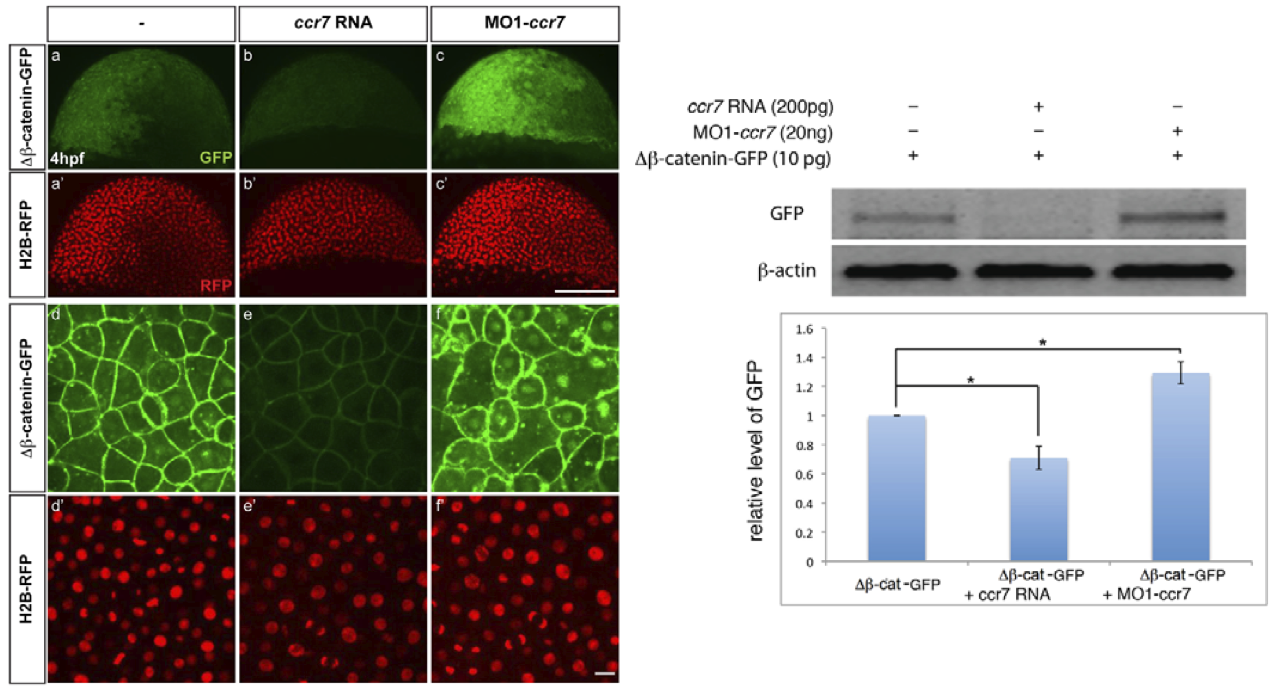本文是关于GFP抗体的全面综述,数据来源于来邦网调查的159篇正式出版文献和GFP抗体使用的常见问题。
A comprehensive review of anti-GFP antibodies including results from Labome survey of 159 formal publications and anti-GFP antibody FAQ.
| 供应商 | 数目 |
|---|---|
| Invitrogen / Life Technologies | 49 |
| Abcam | 35 |
| Roche | 22 |
| Santa Cruz Biotechnology | 17 |
| Clontech | 16 |
| Aves Labs | 7 |
| MBL | 6 |
| EMD Millipore / Chemicon / Merck | 5 |
| Sigma | 5 |
| BD BioSciences | 3 |
| Torrey Pines | 3 |
| Rockland | 2 |
| Biolegend | 2 |
| Miltenyi Biotech | 2 |
| ChromoTek | 2 |
| Nacalai Tesque | 2 |
GFP非常适合用于蛋白质标记,这是它取得空前成功的最大原因之一。虽然它非常适合实时成像,但是在使用方法中如果导致GFP荧光淬灭,那么就有必要使用抗GFP抗体。组织样品,组织学制剂和使用固定剂的冷冻保存,通常导致GFP荧光完全或部分损失,则需要使用GFP抗体来获得可靠的实验结果。通过免疫印迹检测GFP标签蛋白,免疫沉淀检测蛋白质-蛋白质相互作用,这些实验也必须使用GFP抗体。GFP抗体有多克隆或单克隆抗体,适用于蛋白质印迹,免疫沉淀,免疫组化,免疫细胞化学定位和免疫吸附测定(ELISA),以检测GFP,GFP变体和GFP融合蛋白。
| 使用方法 | 供应商 | 参考文献 |
|---|---|---|
| 免疫印迹 | ||
| Roche | 11814460001(7.1/13.1) [3-7] ; [3-18] | |
| Thermo Fisher / Invitrogen | A11122 [19, 20] ; [8, 19-31] | |
| Clontech | JL-8(632380, 632380) [32-36] ; [32-35, 35-42] | |
| Santa Cruz Biotechnology | sc-8334 [43], sc-9996 [44] ; [43-53] | |
| 免疫细胞化学 | ||
| Abcam | ab13970 [54-56] ; [10, 54-60] | |
| Roche | 11814460001(7.1/13.1) [3] ; [3, 9, 18, 61, 62] | |
| Thermo Fisher / Invitrogen | [63-66] | |
| 免疫组化 | ||
| Invitrogen | A11122 [55, 67-69] ; A11120 [70] ; A6455 [71] ; A11039 [72] ; [2, 72-87] | |
| Abcam | ab290 [88, 89] ; ab1218 [90] ; ab13970 [91, 92] ; ab6556 [93] ; [58, 85, 88-106] | |
| Aves Labs | 绿色荧光蛋白-1020 [107-109] ; [76, 107-111] | |
| 免疫沉淀 | ||
| Invitrogen | A11120 [41] ; G10362 [112] ; A11122 [20] ; [8, 20, 22, 29, 41, 112-114] | |
| Santa Cruz Biotechnology | sc-8334 [115] ; [115-118] | |
| ChIP | ||
| Abcam | ab290 [119] | |
| Thermo Fisher / Invitrogen | [114] | |
| Chromtek | [120] | |
| Cell Signaling | [121] | |
| 免疫-电镜 | ||
| Thermo Fisher / Invitrogen | [6] | |
| Abcam | ab6556 [9] | |
| Clontech | [9] | |
GFP抗体使用量在增长,相应供应商的数量也在增加。来邦网调查了159篇文献,汇编了直至2015年8月28日,在已经正式发表的文章中, 提供GFP抗体的供应商列表和相对应的被引用的次数(表1)。基于这项调查,这些抗体的主要供应商的名单和简短评论将在下文呈现。表2列出了抗的不同使用方法。
有些供应商还提供GFP单结构域抗体或纳米抗体。这些抗体包括一个单一可变抗体结构域,这是一种骆驼来源的单结构域抗体。这些抗体比常规抗体小得多,而且有重要的用途。 Caussinus E等人已经率先发明deGradFP方法(图2),该方法利用遗传编码方式,具体为在任何真核系统中,快速消耗GFP标签蛋白 [122] 。此系统依赖于GFP单结构域抗体片段(vhhGFP4)融合到F-box结构域。此融合蛋白结合GFP并直接介导蛋白酶体降解。当GFP标记的蛋白是功能蛋白的唯一来源,那么基因功能的分析就不受残留蛋白的干扰。Ries等人使用GFP标签蛋白和分子量小、亲和力高的单结构域GFP抗体,在微管,神经元和酵母细胞研究中获得纳米级的分辨率 [123] 。
Life Technologies公司最受欢迎的一种GFP抗体是兔多克隆抗体 A11122。它被用于免疫印迹 [19] ,免疫组化 [67-69] ,和免疫沉淀 [41] 。Invitrogen公司的鸡抗GFP抗体以1:500稀释度进行免疫组化实验 [72] 。兔抗GFP抗体以1:1000稀释度来进行免疫细胞化学实验来研究管腔形成期间中Rab11a介导的Cdc42依赖的根尖胞吐网络 [66] ,或以1:500稀释度在db / db小鼠中显示下丘脑神经元移植的效果 [65] ;免疫组化(1:1000)实验表明睡眠可诱导增强果蝇的记忆巩固 [75] ;或者以1:800稀释度来研究正常脑发育 [76] ;1:2000稀释度的实验表明同一祖细胞来源的中间神经元可以在大脑新皮质组装在一起 [79] ;以1:2000稀释度来检测平面细胞极性 [81] ;也可使用在共焦显微镜 [74] ,其它免疫组化实验 [2, 55, 63, 64, 70, 71, 71, 78, 80, 82-85, 124-128], to perform western blot [8, 20-22, 24-29, 31] 或免疫沉淀 [8, 20, 22, 29, 112, 113] 实验。Invitrogen公司的鼠抗GFP抗体以1:200稀释度进行免疫组化实验,结果显示果蝇幼虫视觉系统的结构和功能可被光刺激改变 [77] 。Invitrogen公司的GFP抗体也用来进行ChIP实验,结果表明振子基因表达可被TOC1抑制 [114].
Abcam公司的几个GFP抗体使用广泛: ab290 用于免疫组化 [88, 89] ,免疫印迹 [129] 和 cChIP [119] ; ab13970 用于免疫细胞化学 [54-56] 和免疫组化 [91, 92] ; ab1218 用于免疫组化 [90] 和免疫印迹 [130] ;和 ab6556 兔抗GFP抗体以1:1000稀释度用于免疫组化 [93] 。 Abcam公司的鸡多克隆GFP抗体用于免疫组化来研究刺鼠表达(Agouti expression) [105] ,研究小鼠β-连环蛋白(β-catenin)调控Kras依赖的葡萄状腺发展成PDA癌前体的重编程过程; [131] 采用免疫细胞化学实验研究RAS / Epac2信号通路在维持平层神经元基底树突复杂性中的作用, [96] 和cPLA2a在池内管(intercisternal tubular)的连续性和高尔基复合体运输中的作用 [59] 。FITC标记的羊抗GFP抗体用来进行免疫荧光实验,以研究胞质多聚腺苷酸化和CPE介导的转录调控在视网膜轴突发育中的作用 [10] ;生物素偶联的羊抗GFP抗体用来进行免疫组化实验,结果表明迷走神经通路在脾T细胞合成乙酰胆碱来抑制细胞因子的产生 [102] 。

Santa Cruz公司的GFP抗体 sc-8334 用于免疫共沉淀实验,以研究CCA1和LHY在拟南芥生物节律调控中的作用 [115] ;用于免疫印迹分析,以探讨类鼻疽杆菌(Burkholderia pseudomallei)来源的CHBP蛋白作为蛋白抑制剂,在真核细胞泛素化途径中的作用 [43] 。Santa Cruz公司的GFP抗体 sc-9996 用于免疫印迹实验,验证了肿瘤细胞的异倍体性与STAG2失活相关 [44] 。Santa Cruz公司的GFP单克隆抗体用于免疫印迹,来研究在非典型法布瑞氏症中,DGJ在增强GLA酶活性和蛋白表达中的作用 [50] ;并研究Rho GDP解离抑制子2(RhoGDI 2)的抗肿瘤作用 [46] 。Santa Cruz Biotechnology公司的兔多克隆绿色荧光蛋白抗体用于免疫沉淀实验,来研究一种新的蛋白抑制剂FIP200对黏着斑激酶的调控作用 [116] ;用于免疫印迹实验研究线粒体凋亡中Bcl-2的作用 [53] 。
Roche(罗氏)公司的鼠单克隆GFP抗体(克隆7.1 / 13.1,产品目录号11814460001)用来进行免疫印迹分析,以阐释SIRT6促进DNA末端切除的机制 [4] ;验证极光激酶B介导的细胞脱落由ESCRT-III进行调节 [5] ;以及其他免疫印迹应用 [3, 6, 7] 。罗氏应用科学的鼠单克隆GFP抗体可用来进行免疫细胞化学实验,来研究在不同类型细胞中网格蛋白在受体介导内吞作用中的作用 [132] ,证实生化信号网络可以在嘈杂的分子环境中传输信息 [62] 。用于免疫印迹实验,来研究在细胞周期中细胞核输出Fus2p的调节作用 [11] ;细胞质多聚腺苷酸化和CPE介导的转录调控在视网膜轴突发育中的作用 [10] ;一些65kD的鸟苷酸结合蛋白在保护宿主免受细菌感染中的作用 [16] ;并证实拟南芥细胞区室特异性的免疫应答由EDS1作为连接子进行诱导的 [17] 。罗氏公司的GFP抗体(1:500)被用于ELISA实验,研究证实DNA复制和修复过程中的损伤是由于PCNA伴侣蛋白之间相互作用的细微改变而导致 [133] 。
Clontech公司的鼠单克隆GFP抗体(克隆JL-8,产品目录号:632380,632459)被用来进行免疫组化实验,以研究Nup153在有丝分裂中的作用 [88] ;以1:1000稀释度进行免疫印迹实验,以证实酵母年龄相关的损伤可以在配子形成时消除 [32] ,以及研究线虫中piRNA的特征 [34] ,等等 [33, 35, 36] 。
GFP抗体的使用方法是决定供应商的一个重要因素。供应商列出抗体最合适的使用方法,并且给出建议的稀释度。然而,抗体性能可能与系统和实验条件有关。许多供应商提供客户支持服务,这可以就他们公司抗体是否适合您的实验来给出建议。
GFP抗体识别维多利亚多管发光水母(Aequorea victoria)GFP蛋白的其它变体。
免疫印迹实验中的信号缺失可能存在多种问题。转膜失败和转膜效率极差都导致无信号。转膜效率可以通过丽春-S染色进行检测。气泡的存在也会导致转膜效率差。GFP标记蛋白的表达水平可能太低,提高上样体积,并包含阳性对照。抗体浓度非常稀也可能是个问题,多试几个不同浓度的抗体来检测免疫印迹。此外,一个极小的可能性是,GFP标签没有同步表达和不表达也可导致信号缺失。
在某些实验条件下,GFP荧光会部分或完全丢失。因此,表达GFP标记蛋白的一些细胞结构可能难以显现或成像。GFP-Booster是骆驼来源的VHH结构域结合蛋白耦合了强信号荧光染料,能稳定并增强荧光信号。
绿色荧光蛋白(GFP)是来自维多利亚多管发光水母 Aequorea victoria的一个小分子量蛋白质。它是由Osamu Shimomura发现的,当被蓝色到紫外区的光刺激时发出绿色荧光。相关荧光蛋白在许多其它海洋生物中发现,例如珊瑚,海葵和海紫罗兰。当Martin Chalfie证明了GFP基因可以克隆和表达并可作为发光标记,GFP成为一个非常流行的工具。从那时起,GFP在细菌,酵母,slime mods,蠕虫,果蝇,斑马鱼,哺乳动物细胞系和植物中都表达过。GFP可以进行N-和C-端蛋白融合,并且不需要任何辅助因子来发出荧光,这使得它是使用最广泛的蛋白标签之一。这一开创性工作为研究细胞和发育生物学的重要问题开辟了新的途径。通过众多科学家的努力,尤其是Roger Tsien小组,GFP的颜色已延伸到绿色以外。这使得可以使用多个变体同时跟踪多种生命过程。在2008年,Osamu Shimomura, Martin Chalfie和 Roger Tsien共同获得诺贝尔化学奖以表彰他们对于GFP研究的贡献。

GFP形成非常稳定桶状结构,由11个β折叠片层环绕着一个中心α螺旋。β折叠通过脯氨酸富集的柔性区域连接。每个β折叠片层的侧链交替进入蛋白结构中心或表面。GFP发色团由Ser65,Tyr66和Gly67的分子内环化形成的,几乎位于桶状的中心 [134] 。虽然这三个氨基酸基序在自然界中是常见的,但是不会产生荧光。GFP的β-桶的独特内部环境形成发色团,并保护它免受淬火 [135] 。发色团的形成是自动催化 [135] 。GFP主要存在395 nm激发光下的质粒化状态中,少量存在于475 nm激发光下的非质子状态中 [136] 。这两种形式的荧光辐射峰都在510 nm。
由于GFP在生物科学领域流行,很多努力一直致力于荧光的微调。水母绿色GFP是非常明亮,耐光,但其最大激发光(395 nm)位于紫外区的边界。在成像时,紫外线会损伤细胞结构。突变体筛选获得了一个点突变S65T,其最大激发光波长转移到488 nm [137] 。该变体被称为“EGFP”,避免了使用紫外光激发的问题,并且可以使用异硫氰酸荧光素(FITC)滤波器很容易地进行成像。它也是最亮和最耐光GFP。然而,使用GFP的一个重要缺陷在于它的光谱性质受pH值影响。当它被定位到酸性区室,如内含体或溶酶体,GFP荧光就被淬灭。
利用突变策略,GFP的颜色已经不单单只有绿色。蓝色,青色和黄色荧光蛋白(分别为BFP,CFP和YFP),都是从GFP衍生而来,已被证明是非常有价值的研究工具。研究探讨了其他颜色的珊瑚和海葵中天然存在的荧光蛋白,除了黄色,红移GFP一直没有成功 [138, 139] 。接下来的努力是获得具有令人满意的光谱特性的其它荧光蛋白质,使其可以在多色标记中使用。
使用GFP变体以及其他来源的荧光蛋白使研究人员能够通过荧光共振能量转移(FRET)和荧光漂白恢复(FRAP)同时跟踪各种生命现象。一个有关荧光蛋白的最有趣的和令人印象深刻的实验,是利用大脑彩虹(brainbow)技术来研究神经回路是如何组织的 [140] 。通过随机表达不同比例的红色,绿色和蓝色的变体,大脑神经元被不同颜色点亮。对比只能使用少数变体的多标签技术,大脑彩虹技术非常灵活,并且可以在单个神经元中形成高达100种的不同色调。
- Bhattacharya R, SenBanerjee S, Lin Z, Mir S, Hamik A, Wang P, et al. Inhibition of vascular permeability factor/vascular endothelial growth factor-mediated angiogenesis by the Kruppel-like factor KLF2. J Biol Chem. 2005;280:28848-51 pubmed
- Park J, Kim G, Kim S, Ko J, Lee J, Yoo H. Effects of a chemical chaperone on genetic mutations in alpha-galactosidase A in Korean patients with Fabry disease. Exp Mol Med. 2009;41:1-7 pubmed
- Qu J, Liu G, Wu K, Han P, Wang P, Li J, et al. Nitric oxide destabilizes Pias3 and regulates sumoylation. PLoS ONE. 2007;2:e1085 pubmed
- Lin C, Chen C, Chang W, Jan M, Hsu L, Wu R, et al. Bcl-2 rescues ceramide- and etoposide-induced mitochondrial apoptosis through blockage of caspase-2 activation. J Biol Chem. 2005;280:23758-65 pubmed
- Abbi S, Ueda H, Zheng C, Cooper L, Zhao J, Christopher R, et al. Regulation of focal adhesion kinase by a novel protein inhibitor FIP200. Mol Biol Cell. 2002;13:3178-91 pubmed
- Yang F, Moss L, Phillips G. The molecular structure of green fluorescent protein. Nat Biotechnol. 1996;14:1246-51 pubmed
- Zimmer M. Green fluorescent protein (GFP): applications, structure, and related photophysical behavior. Chem Rev. 2002;102:759-81 pubmed
- Tsien R. The green fluorescent protein. Annu Rev Biochem. 1998;67:509-44 pubmed
- Heim R, Cubitt A, Tsien R. Improved green fluorescence. Nature. 1995;373:663-4 pubmed
- Matz M, Fradkov A, Labas Y, Savitsky A, Zaraisky A, Markelov M, et al. Fluorescent proteins from nonbioluminescent Anthozoa species. Nat Biotechnol. 1999;17:969-73 pubmed
- Merzlyak E, Goedhart J, Shcherbo D, Bulina M, Shcheglov A, Fradkov A, et al. Bright monomeric red fluorescent protein with an extended fluorescence lifetime. Nat Methods. 2007;4:555-7 pubmed
- Livet J, Weissman T, Kang H, Draft R, Lu J, Bennis R, et al. Transgenic strategies for combinatorial expression of fluorescent proteins in the nervous system. Nature. 2007;450:56-62 pubmed

